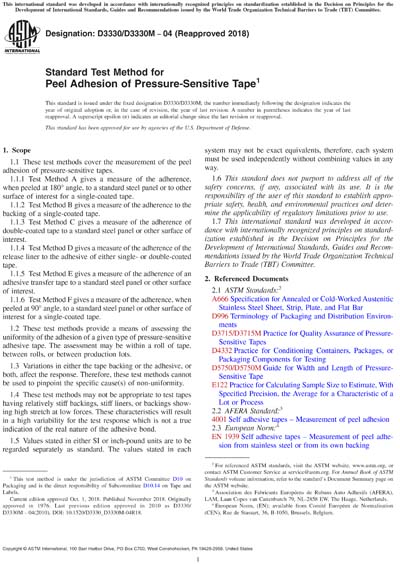Most recent
ASTM D3330/D3330M-04(2018)
Standard Test Method for Peel Adhesion of Pressure-Sensitive Tape
1.1 These test methods cover the measurement of the peel adhesion of pressure-sensitive tapes.
1.1.1 Test Method A gives a measure of the adherence, when peeled at 180° angle, to a standard steel panel or to other surface of interest for a single-coated tape.
1.1.2 Test Method B gives a measure of the adherence to the backing of a single-coated tape.
1.1.3 Test Method C gives a measure of the adherence of double-coated tape to a standard steel panel or other surface of interest.
1.1.4 Test Method D gives a measure of the adherence of the release liner to the adhesive of either single- or double-coated tape.
1.1.5 Test Method E gives a measure of the adherence of an adhesive transfer tape to a standard steel panel or other surface of interest.
1.1.6 Test Method F gives a measure of the adherence, when peeled at 90° angle, to a standard steel panel or other surface of interest for a single-coated tape.
1.2 These test methods provide a means of assessing the uniformity of the adhesion of a given type of pressure-sensitive adhesive tape. The assessment may be within a roll of tape, between rolls, or between production lots.
1.3 Variations in either the tape backing or the adhesive, or both, affect the response. Therefore, these test methods cannot be used to pinpoint the specific cause(s) of non-uniformity.
1.4 These test methods may not be appropriate to test tapes having relatively stiff backings, stiff liners, or backings showing high stretch at low forces. These characteristics will result in a high variability for the test response which is not a true indication of the real nature of the adhesive bond.
1.5 Values stated in either SI or inch-pound units are to be regarded separately as standard. The values stated in each system may not be exact equivalents, therefore, each system must be used independently without combining values in any way.
1.6 This standard does not purport to address all of the safety concerns, if any, associated with its use. It is the responsibility of the user of this standard to establish appropriate safety, health, and environmental practices and determine the applicability of regulatory limitations prior to use.
1.7 This international standard was developed in accordance with internationally recognized principles on standardization established in the Decision on Principles for the Development of International Standards, Guides and Recommendations issued by the World Trade Organization Technical Barriers to Trade (TBT) Committee.
Content Provider
ASTM International [astm]






